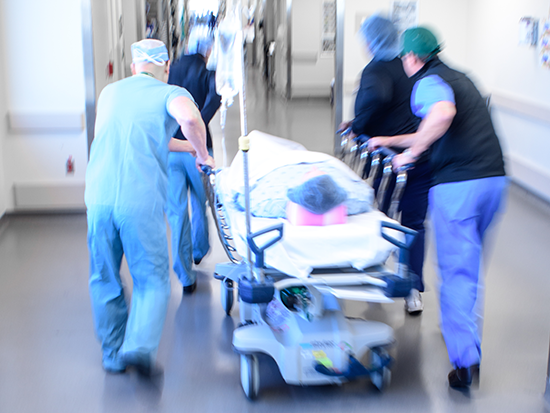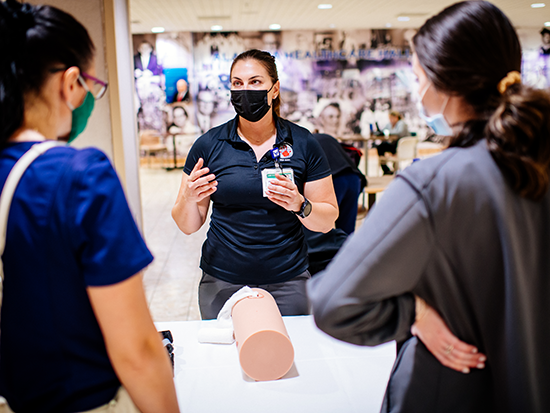Media contact: Anna Jones
 In addition to providing excellent trauma care, UAB surgeons continue to establish innovative programs to better improve trauma care in Alabama.
In addition to providing excellent trauma care, UAB surgeons continue to establish innovative programs to better improve trauma care in Alabama.
Photography: Steve WoodZero preventable deaths — that is the shared goal of trauma surgeons across the country, including at the University of Alabama at Birmingham.
Trauma is the most common cause of death for patients younger than 45 years of age, according to the Alabama Chapter of the American College of Surgeons. Trauma injuries account for 30 percent of all life years lost in the United States, compared to cancer, which accounts for 16 percent, and heart disease, which accounts for 12 percent. Eighty percent of trauma cases are caused by blunt force injury due to vehicular crashes or falls.
“Our goal of zero preventable deaths drives the mission of trauma professionals at UAB,” said Jeffrey Kerby, M.D., Ph.D., director of the UAB Division of Trauma and Acute Care Surgery. “The key to reaching this goal is to ensure the appropriate level of care is provided during what is known as the ‘golden hour,’ which is the most crucial window of time after traumatic injury.”
The golden hour is the first 60 minutes after a patient has a traumatic injury. Within this window, appropriate lifesaving medical or surgical intervention is needed to offer the patient the highest chance of survival. Unfortunately, more than 40 million Americans, including 60 percent of Alabamians, live more than an hour away from a trauma center. Accessibility to timely care is a challenge and is one of the underlying reasons that 69 percent of the state’s trauma deaths happen in rural areas.
UAB Hospital remains the only American College of Surgeons-verified adult Level I trauma center in Alabama and cares for nearly one-third of all trauma patients in the state. Kerby says 96 percent of all patients treated for traumatic injuries at UAB survive. UAB is currently providing its fastest time to the operating room for hemorrhage control at an average of 33 minutes compared to the national average which is 55 minutes. In addition to providing excellent trauma care, UAB surgeons continue to establish innovative programs to better improve trauma care in Alabama.
Beyond the Emergency Department
To address the trauma care gap, the division established multiple teams and programs, including the SWIFT team, or the Surgical forWard Intervention for Trauma team. This team focuses on innovative approaches to pre-hospital care — incorporating new technologies and taking doctors to the scene — with the goal to help reduce preventable deaths after injury.
The division has military-civilian partnerships with the United States Air Force and has hosted Air Force Pararescue Specialists, also known as PJs, and Special Operations Independent Duty Medical Technicians for two-week training rotations to keep their medical skills sharp in between deployments.
Alabama has a trauma resource available known as the Trauma Communication Center — a 24/7/365 service that monitors the status of every trauma hospital in the state to route patients to the right hospital for their injuries. This program is one of only a few of its kind in the nation.
The collaboration was started under the leadership of Kerby, who in 2003 came back to UAB after active-duty service in the Air Force following completion of his surgical residency. The program was designed to fully integrate the PJs and medics into UAB trauma teams, giving them ample hands-on experience, like putting in IVs and chest tubes, performing operating room intubations, and assessing, triaging and managing trauma patients. Labs, virtual reality and a field training exercise are part of the training.
This partnership also includes the Special Operations Surgical Teams, which have been stationed at UAB since 2010. Each SOST team includes a surgeon, a nurse, a scrub tech, an emergency medical physician, a respiratory therapist and an anesthesiologist. These teams are ready at a moment’s notice to deploy to various locations and dangerous situations across the globe, providing trauma resuscitation and lifesaving surgical care.
In addition to programs that are focused on patient care at the hospital, the division has programs to support trauma survivors after they leave the hospital. Last year, UAB Hospital in collaboration with the Offender Alumni Association, the Jefferson County Department of Health and the City of Birmingham, launched its hospital-based violence intervention program to support patients who are Jefferson County residents between the ages of 19 and 39 who have survived a non-self-inflicted gunshot injury. While still in the hospital, patients are paired with violence intervention specialists who follow up with them over months, providing connections to social, medical and mental health services and monitoring survivors’ progress over time. The objectives of the program include reducing subsequent acts of violence involving the clients, improving client health outcomes, and enhancing client educational attainment, employability and employment status.
Additionally, UAB’s chapter of the Trauma Survivors Network is an initiative of the American Trauma Society. Its mission is to support trauma patients and their families — from their immediate questions to their long-term emotional needs. The TSN provides programs like the NextSteps program, an online course that helps survivors set new goals and manage their lives after trauma, and peer mentoring, which pairs a compassionate, trained trauma survivor with a current trauma patient in the hospital to answer questions and provide hope in a way that only someone who has truly been there themselves can do. To join the TSN, visit uabmedicine.org.
“In addition to caring for our patients in the hospital, we’re also working outside of the hospital in the realm of injury prevention, community education and advocacy to reduce the number of traumatic injuries and preventable deaths across the state,” Kerby said.
Prevention through outreach and education
 UAB offers injury prevention and trauma care courses across the state to schools, churches, senior centers, hospitals and other groups on demand.
UAB offers injury prevention and trauma care courses across the state to schools, churches, senior centers, hospitals and other groups on demand.
Photography: Steve WoodThe trauma professionals at UAB are not just focused on saving lives — they want to prevent injury before it happens and share their expertise and knowledge to improve trauma care. UAB offers injury prevention and trauma care courses across the state to schools, churches, senior centers, hospitals and other groups on demand.
- Stop the Bleed is a national campaign from the American College of Surgeons, that empowers bystanders to save lives by knowing how to stop bleeding within minutes using techniques like packing the wound, applying pressure and using a tourniquet. UAB started offering Stop the Bleed courses in 2017 and has provided kits and training to schools and churches around Birmingham.
- Fall prevention in the elderly population, as it makes up a significant percentage of UAB’s trauma cases. UAB’s injury prevention team offers Bingocize, an evidence-based program that combines bingo, exercises including range of motion and balance, and fall prevention tips.
- Burn prevention is an education program offered through UAB’s burn medical professionals, who offer insight on essential burn prevention; fire safety; what to do in the case of a fire; how to initially treat burn wounds; how to prevent common cooking-related injuries like scalds and burns from grills, grease and boiling water; and more.
- Advanced Trauma Life Support teaches how to assess a patient’s condition, resuscitate and stabilize them, and determine whether their needs exceed a facility’s capacity. It covers inter-hospital transfer, making it ideal for hospitals that do not usually provide trauma care.
- Basic Endovascular Skills for Trauma teaches endovascular techniques to halt life-threatening hemorrhage.
- Rural Trauma Team Development Course emphasizes a team approach to the initial evaluation and resuscitation of the trauma patient at a rural facility and teaches how to determine whether a patient needs to be transferred to a higher level of care.
The division hosts events to celebrate survivors and their health care team members throughout the year.
Celebrating survivors, first responders and health care professionals
Ninety-six percent of all patients treated for traumatic injuries at UAB survive.
In honor of Trauma Awareness Month in May, the UAB Division of Trauma and Acute Care Surgery is hosting its first-ever Heroes and Healers Gala, on Friday, May 3, at 6:30 p.m. The event will take place at Haven, located at 2515 Sixth Ave. South, Birmingham, AL 35233.
At this event, attendees will recognize and celebrate survivors of traumatic injury and their families, as well as the first responders and health care professionals who saved their lives and helped them on their road to recovery.
Tickets are $30, and proceeds from the event will go toward the UAB chapter of the Trauma Survivors Network to support programs for trauma survivors and their families. A ticket purchase includes dinner, dessert and two drink tickets. Attendees will get to view the premiere of mini-movies about three trauma survivor honorees, followed by an invitation to take to the dance floor. Tickets can be purchased online until May 2 here. On the day of the event, tickets can be purchased at the door.